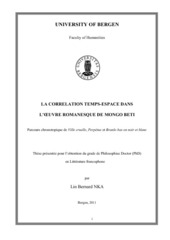| dc.description.abstract | This work is an exploration of Bakhtin’s chronotope in the novel of the Cameroonian writer Mongo Beti, whose pen has relentlessly been exposing, for nearly half a century, the abuses of colonialism and neo-colonialism on African territory. More specifically, it is a reading of indices of time-space in a corpus including Ville cruelle, his first novel written at the time of colonization, Perpétue et l’habitude du malheur, a novel of the dark ages of post-independence dictatorships and Branle-bas en noir et blanc, his last novel, published in the era of globalization. This study has emerged from the observation that Mongo Beti’s writings, though strongly marked by time and space by the periods they cover, the African space they talk about and the existential questions they raise, have not, to our knowledge, been specifically studied in a time-space (chronotopical) perspective. In an attempt to confirm the great heuristic potentials of the chronotope as a tool for research, the analysis and interpretations of data enable to reveal, in Mongo Beti’s novels, specific chronotopical dimensions that enrich those already developed by Bakhtin. The point is made that the chronotope is not a prescriptive theory, but a malleable concept that develops and constructs itself from the indices of the corpus studied. Each of the novels is built around dominant time-space sequences that reveal the existential journey of the protagonists to an uncertain destiny while fitting into a great unifying chronotope. Thus, Ville cruelle represents the encounter marked by the drama of broken idyll, Perpétue the selfdestruction of a nation, a denial of life and the idyll in reverse while Branle-bas scrambles, extends and dissipates time and space in a globalizing world where here and elsewhere are confused. All this suggests a labyrinth within which the character moves, unlike the vicious circle usually mentioned and almost universally accepted. | en_US |
